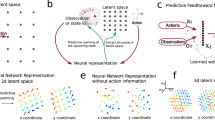Abstract
This paper considers the problem of training layered neural networks to generate sequences of states. Aiming at application for situations when an integral characteristic of the process is known rather than the specific sequence of states we put forward a method in which underlying general principle is used as a foundation for the learning procedure. To illustrate the ability of a network to learn a task and to generalize algorithm we consider an example where a network generates sequences of states referred to as trajectories of motion of a particle under an external field. Training is grounded on the employment of the least action principle. In the course of training at restricted sections of the path the network elaborates a recurrent rule for the trajectory generation. The rule proves to be equivalent to the correct equation of motion for the whole trajectory.
Similar content being viewed by others
References
Amit DJ (1988) Neural networks counting chimes. Proc Natl Acad Sci USA 85:2141–2145
Anshelevich W, Amirikian BR, Lukashin AV, Frank-Kamenetskii MD (1989) On the ability of neural networks to perform generalization by induction. Biol Cybern 61:125–128
Dehaene S, Changeux JP, Nadal JP (1987) Neural networks that learn temporal sequences by selection. Proc Natl Acad Sci USA 84:2727–2731
Gutfreund H, Mezard M (1988) Processing of temporal sequences in neural networks. Phys Rev Lett 61:235–238
Guyon I, Personnaz L, Nadal JP, Dreyfus G (1988) Storage and retrieval of complex sequences in neural networks. Phys Rev A38:6365–6372
Gyorgyi G (1990) Inference of a rule by a neural network with thermal noise. Phys Rev Lett 64:2957–2960
Jordan MI (1986) Attractor dynamics and parallelism in a connectionist sequential machine. Proceedings of the 8th Annual Conference of the Cognitive Science Society. Erlbaum, Hillsdale, NJ
Josin G (1988) Neural-space generalization of a topological transformation. Biol Cybern 59:283–290
Kirkpatrick S, Gelatt CD, Vecchi MP (1983) Optimization by simulated annealing. Science 220:671–680
Kleinfeld D (1986) Sequential state generation by model neural networks. Proc Natl Acad Sci USA 83:9469–9473
Landau LD, Lifshitz EM (1965) Mechanics. Nauka, Moscow (in Russian)
Lukashin AV (1990) A learned neural network that simulates properties of the neuronal population vector. Biol Cybern 63:377–382
Massone L, Bizzi E (1989) A neural network model for limb trajectory formation. Biol Cybern 61:417–425
Nishimori H, Nakamura T (1990) Retrieval of spatio-temporal sequence in asynchronous neural network. Phys Rev A41:3346–3354
Patarnello S, Carnevali P (1987) Learning network of neurons with Boolean logic. Europhys Lett 4:503–508
Rumelhart DE, McClelland JL (1986) Parallel distributed processing: Explorations in the microstructure of cognition, vols 1, 2. MIT Press, Cambridge
Schoner G, Kelso JAS (1988) Dynamic pattern generation in behavioral and neural systems. Science 239:1513–1520
Sompolinsky H, Kanter I (1986) Temporal association in asymmetric neural networks. Phys Rev Lett 57:2861–2864
Author information
Authors and Affiliations
Rights and permissions
About this article
Cite this article
Amirikian, B.R., Lukashin, A.V. A neural network learns trajectory of motion from the least action principle. Biol. Cybern. 66, 261–264 (1992). https://doi.org/10.1007/BF00198479
Received:
Accepted:
Issue Date:
DOI: https://doi.org/10.1007/BF00198479




